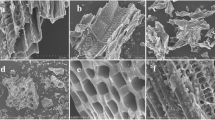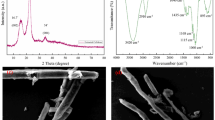Abstract
A chemically crosslinked cellulose ester films (MCC-CAD-GA) based on cellulose (MCC), citric acid anhydride (CAD) and l-glutamic acid (l-GA) was successfully prepared via amidation for the adsorption of Cd2+, Co2+, Ni2+, Pb2+ and Cu2+ ions with lower concentration from water. The obtained composites were characterized by FTIR, XRD, elemental analysis and SEM. The results showed that the thermal stability and mechanical strength of MCC-CAD-GA films were enhanced. The adsorption parameters, such as temperature, contact time, adsorbent dose, pH, and initial metal ion concentration were optimized. The adsorption capability of the composite for heavy metal ions was substantially and synergistically improved by adding l-GA into MCC-CAD. The composite films could be recycled and exhibited constant adsorption ability for five successful runs. In addition, the adsorption behavior followed the pseudo-second order kinetic model, and the adsorption isotherms were well described by the Langmuir model. All the results suggested that the MCC-based composite films could be considered as a promising candidate for heavy metal ions treatment.
Graphic Abstract
A chemically crosslinked cellulose ester films based on cellulose (MCC), citric acid anhydride (CAD) and l-glutamic acid (l-GA) was successfully prepared via amidation for the adsorption of Cd2+, Co2+, Ni2+, Pb2+ and Cu2+ ions with lower concentration from water. The modified could be recycled and exhibited constant adsorption performance for five successful runs.








Similar content being viewed by others
References
Rahmi L, Julinawati S (2017) Preparation of chitosan composite film reinforced with cellulose isolated from oil palm empty fruit bunch and application in cadmium ions removal from aqueous solutions. Carbohydr Polym 170:226–233
Zhao Y, Sun Q, Luo J, Chen H, Cai W, Su X (2018) Hydrothermal fabrication of TiO2-MoO3 nanocomposites with superior performance for water treatment. Nano-Struct Nano-Objects 13:93–99
Adekunle AS, Oyekunle JAO, Durosinmi LM et al (2019) Potential of cobalt and cobalt oxide nanoparticles as nanocatalyst towards dyes degradation in wastewater. Nano-Struct Nano-Objects 21:100405. https://doi.org/10.1016/j.nanoso.2019.100405
Cao J, Tan Y, Che Y, Xin H (2010) Novel complex gel beads composed of hydrolyzed polyacrylamide and chitosan: an effective adsorbent for the removal of heavy metal from aqueous solution. Bioresour Technol 101:2558–2561
Thomas S, Pasquini D, Leu S, Gopakumar DA (2018) Nanoscale materials in water purification. Elsevier, Amsterdam
Malik LA, Bashir A, Manzoor T, Pandith AH (2019) Microwave-assisted synthesis of glutathione-coated hollow zinc oxide for the removal of heavy metal ions from aqueous systems. RSC Adv 9:15976–15985
Huang J, Yuan F, Zeng G, Li X, Gu Y, Shi L, Liu W, Shi Y (2017) Influence of pH on heavy metal speciation and removal from wastewater using micellar enhanced ultrafiltration. Chemosphere 173:199–206
Gopakumar DA, Arumukhan V, Gelamo RV, Pasquini D, de Morais LC, Rizal S, Hermawan D, Nzihou A, Abdul Khalil HPS (2019) Carbon dioxide plasma treated PVDF electrospun membrane for the removal of crystal violet dyes and iron oxide nanoparticles from water. Nano-Struct Nano-Objects 18:100268–100276
Pedersen KB, Jensen PE, Ottosen LM, Evenset A, Christensen GN, Frantzen M (2017) Metal speciation of historic and new copper mine tailings from Repparfjorden, Northern Norway, before and after acid, base and electrodialytic extraction. Miner Eng 107:100–111
Xu J, Zhao G, Huang X, Guo H, Liu W (2017) Use of horizontal subsurface flow constructed wetlands to treat reverse osmosis concentrate of rolling wastewater. Int J Phytoremediat 19(3):262–269
Mangalam J, Kumar M, Sharma M, Joshi M (2019) High adsorptivity and visible light assisted photocatalytic activity of silver/reduced graphene oxide (Ag/rGO) nanocomposite for wastewater treatment. Nano-Struct Nano-Objects 17:58–66
Wang X, Lü S, Gao C, Feng C, Xu X, Bai X, Gao N, Yang J, Liu M, Wu L (2016) Recovery of ammonium and phosphate from wastewater by wheat straw-based amphoteric adsorbent and reusing as a multifunctional slow-release compound fertilizer. ACS Sustain Chem Eng 4(4):2068–2079
Nguyen TAH, Ngo HH, Guo WS, Zhang J, Liang S, Yue QY, Li Q, Nguyen TV (2013) Applicability of agricultural waste and byproducts for adsorptive removal of heavy metals from wastewater. Bioresource Technol 148:574–585
Bilal M, Shah JA, Ashfaq T, Gardazi SMH, Tahir AA, Pervez A, Haroon H, Mahmood Q (2013) Waste biomass adsorbents for copper removal from industrial wastewater—a review. J Hazard Mater 263(2):322–333
Hegazi HA (2013) Removal of heavy metals from wastewater using agricultural and industrial wastes as adsorbents. HBRC J 9:276–282
Ghaee A, Shariaty-Niassar M, Barzin J, Zarghan A (2012) Adsorption of copper and nickel ions on macroporous chitosan membrane: equilibrium study. Appl Surf Sci 258:7732–7743
Labid A, Salaberria AM, Fernandes SCM, Labidi J, Abderrabba M (2016) Adsorption of copper on chitin-based materials: kinetic and thermodynamic studies. J Taiwan Inst Chem Eng 65:140–148
Balakrishnan P, Geethamma VG, Gopi S, Thomas MG, Kunaver M, Huskić M, Kalarikkal N, Volova T, Rouxel D, Thomas S (2019) Thermal, biodegradation and theoretical perspectives on nanoscale confinement in starch/cellulose nanocomposite modified via green crosslinker. Int J Biol Macromol 134:781–790
Wang N, Jin RN, Omer AM, Yang XKO (2017) Adsorption of Pb(II) from fish sauce using carboxylated cellulose nanocrystal: isotherm, kinetics, and thermodynamic studies. Int J Biol Macromol 102:232–240
Voisin H, Bergström L, Liu P, Mathew AP (2017) Nanocellulose-based materials for water purification. Nanomaterials 7:57–75
Vadakkekara GJ, Thomas S, Nair CPR (2019) Maleic acid modified cellulose for scavenging lead from water. Int J Biol Macromol 129:293–304
Zehra O, Püren Sahin C, Esen E, Gurdag G, Kasgoz H (2016) The effect of extractant on the removal of heavy metal ions by thermoresponsive cellulose graft copolymer. J Environ Chem Eng 2(4):1948–1954
Gopakumar DA, Pasquini D, Henrique MA, de Morais LC, Grohens Y, Thomas S (2017) Meldrum's acid modified cellulose nanofiber-based polyvinylidene fluoride microfiltration membrane for dye water treatment and nanoparticle removal. ACS Sustain Chem Eng 2(5):2026–2033
Velempini T, Pillay K, Mbianda XY, Arotiba OA (2017) Epichlorohydrin crosslinked carboxymethyl cellulose-ethylenediamine imprinted polymer for the selective uptake of Cr(VI). Int J Biol Macromol 101:837–844
Luo X, Yuan J, Liu Y, Liu C, Zhu X, Dai X, Ma Z, Wang F (2017) Improved solid-phase synthesis of the phosphorylated cellulose microsphere adsorbents for highly effective Pb2+ removal from water: the batch and fixed-bed column performance and the adsorption mechanism. ACS Sustain Chem Eng 5(6):5108–5117
El-Magied MOA, Galhoum AA, Atia AA, Tolba AA, Maize MS, Vincent T, Guibal E (2017) Cellulose and chitosan derivatives for enhanced sorption of erbium(III). Colloids Surf A Physicochem Eng Asp 529:580–593
Wang LY, Wang MJ (2016) Removal of heavy metal ions by poly (vinyl alcohol) and carboxymethyl cellulose composite hydrogels prepared by a freeze−thaw method. ACS Sustain Chem Eng 4(5):2830–2837
Su H, Chong Y, Wang J, Long D, Qiao W, Ling L (2018) Nanocrystalline celluloses-assisted preparation of hierarchical carbon monoliths for hexavalent chromium removal. J Colloid Interface Sci 510:77–85
Gebru KA, Das C (2018) Removal of chromium (VI) ions from aqueous solutions using amine impregnated TiO2 nanoparticles modified cellulose acetate membranes. Chemosphere 191:673–684
Fakhre NA, Ibrahim BM (2018) The use of new chemically modified cellulose for heavy metal ion adsorption. J Hazard Mater 343:324–331
Zhuang C, Shi C, Tao F, Cui Y (2017) Honeycomb structural composite polymer network of gelatin and functional cellulose ester for controlled release of omeprazole. Int J Biol Macromol 105:1644–1653
Ramírez JAÁ, Fortunati E, Kenny JM, Torre L, Foresti ML (2017) Simple citric acid-catalyzed surface esterification of cellulose nanocrystals. Carbohydr Polym 157:1358–1364
Bang S, Ko YG, Kim WI, Cho D, Park WH, Kwon OH (2017) Preventing postoperative tissue adhesion using injectable carboxymethyl cellulose-pullulan hydrogels. Int J Biol Macromol 105(1):886–893
Park YD, Tirelli N, Hubbell JA (2003) Photopolymerized hyaluronic acid-based hydrogels and interpenetrating networks. Biomaterials 24:893–900
Sadeghifar H, Venditti RA, Jur JS, Gorga RE, Pawlak JJ (2017) Cellulose-lignin biodegradable and flexible UV protection film. ACS Sustain Chem Eng 5(1):625–631
Alves JS, dos Reis KC, Menezes EGT, Pereira FV, Pereira J (2015) Effect of cellulose nanocrystals and gelatin in corn starch plasticized films. Carbohydr Polym 115:215–222
Jayaramudu T, Varaprasad K, Kim HC, Kafy A, Kim JW, Kim J (2017) Calcinated tea and cellulose composite films and its dielectric and lead adsorption properties. Carbohydr Polym 171:183–192
Abu-Zurayk RA, Al Bakain RZ, Hamadneh I, Al-Dujaili AH (2015) Adsorption of Pb(II), Cr(III) and Cr(VI) from aqueous solution by surfactant-modified diatomaceous earth: Equilibrium, kinetic and thermodynamic modeling studies. Int J Miner Process 140:79–87
Cai J, Lei M, Zhang Q, He JR, Chen T, Liu S, Fu SH, Li TT, Liu G, Fei P (2017) Electrospun composite nanofiber mats of Cellulose@Organically modified montmorillonite for heavy metal ion removal: design, characterization, evaluation of absorption performance. Composites 92:10–16
Onundi YB, Mamun AA, Al-Khatib MF, Al Saadi MA, Suleyman AM (2011) Heavy metals removal from synthetic wastewater by a novel nano-size composite adsorbent. Int J Environ Sci Technol 8(4):799–806
Wang Z, Barford JP, Hui CW, McKay G (2015) Kinetic and equilibrium studies of hydrophilic and hydrophobic rice husk cellulosic fibers used as oil spill sorbents. Chem Eng J 281:961–969
Hokkanen S, Repo E, Suopajärvi T, Liimatainen H, Niinimaa J, Sillanpää M (2014) Adsorption of Ni(II), Cu(II) and Cd(II) from aqueous solutions by amino modified nanostructured microfibrillated cellulose. Cellulose 21(3):1471–1487
Jiang F, Dinh DM, Hsieh YL (2017) Adsorption and desorption of cationic malachite green dye on cellulose nanofibril aerogels. Carbohydr Polym 173:286–294
Fangueiro D, Bermond A, Santos E, Carapuça H, Duarte A (2005) Kinetic approach to heavy metal mobilization assessment in sediments: choose of kinetic equations and models to achieve maximum information. Talanta 66(4):844–857
O'Connell DW, Birkinshaw C, O'Dwyer TF (2008) Heavymetal adsorbents prepared from the modification of cellulose: a review. Bioresour Technol 99(15):6709–6724
Shukla SR, Pai RS, Shendarkar AD (2006) Adsorption of Ni (II), Zn (II) and Fe (II) on modified coir fibres. Sep Purif Technol 47(3):141–147
Bardestani R, Roy C, Kaliaguine S (2019) The effect of biochar mild air oxidation on the optimization of lead(II) adsorption from wastewater. J Environ Manag 240:404–420
Dong C, Zhang H, Pang Z, Liu Y, Zhang F (2013) Sulfonated modification of cotton linter and its application as adsorbent for high-efficiency removal of lead(II) in effluent. Bioresour Technol 146:512–518
Abdel-Aal SE, Gad Y, Dessouki AM (2006) The use of wood pulp and radiation modified starch in wastewater treatment. J Appl Polym Sci 99:2460–2469
Acknowledgements
This work was financially supported by a Project of Shandong Province Higher Educational Science and Technology Program (No. J18KZ004).
Author information
Authors and Affiliations
Corresponding author
Additional information
Publisher's Note
Springer Nature remains neutral with regard to jurisdictional claims in published maps and institutional affiliations.
Electronic supplementary material
Below is the link to the electronic supplementary material.
Rights and permissions
About this article
Cite this article
Ren, J., Tao, F. & Cui, Y. l-Glutamic Acid Crosslinked Cellulose Ester Films for Heavy Metal Ions Adsorption. J Polym Environ 28, 1302–1314 (2020). https://doi.org/10.1007/s10924-020-01690-2
Published:
Issue Date:
DOI: https://doi.org/10.1007/s10924-020-01690-2




